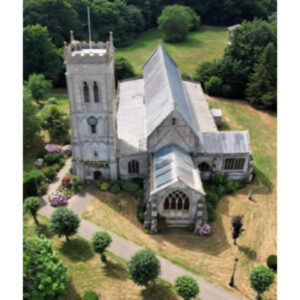
CLICK IMAGE ABOVE TO VIEW 360 TOUR
This magnificent church of St. Mary’s, Whaplode, is not only so impressive from the outside, but also on entering it one is overcome by the sheer size and ‘Minster’ feel to this historic building, which is now nearing 900 years old, with a celebration of its noble history due in 2025.
The official consecration of the Norman church of “The Blessed Virgin St. Mary, Whaplode” is generally accepted as having been in 1125. Other suggested dates of 1130 & 1140 do not align with the architectural evidence of the early Norman Chancel Arch and the four Norman bays in the east end. From its consecration, the ownership of the church at Whaplode, and control over the surrounding land, was contested by the monks at Croyland (Crowland) Abbey over many years, and this was only resolved when the monks established their rights by law, finally, before the Bishop of Lincoln, in 1447. However, despite this affirmation, there remained ongoing disputes, until eventually, in 1594, post reformation, St. Mary’s, Whaplode (“St. Mary’s”), as it was then known, was placed into the ownership of the Archdeacon of Leicester, Robert Johnson, by Her Majesty Queen Elizabeth I.
However, whilst Queen Elizabeth’s appointee of Robert Johnson, in 1594, was responsible for the fabric of St Mary’s ‘Chancel’, the Monarch retained the direct responsibility for the nomination and appointment of the St. Mary’s clergy, hence St Mary’s unique standing within the hierarchy of Church governance, in so far as it is aligned with those churches that are classified as being of a ‘Royal Peculiar’ status, whereby any change in a stipendiary appointment is required to be sanctioned by the Monarch of the day.
Historically, this unique situation arose from medieval times whereby the exercise of the Crown’s parochial patronage was divided between the Monarch and the Lord Chancellor (on behalf of the Monarch) as determined by the size of the benefice, and the earliest formal evidence of the Monarch’s involvement to be found within St Mary’s Parochial Church Council registers is dated 15th November 1613, and latterly appointments have been overseen by the Lord Chancellor under whose direct patronage St. Mary’s Church exists to this day.
The architectural history of St. Mary’s is of immense importance because of what historians generally now believe to be its earlier Saxon origins, and its subsequent Norman development, and it can rightfully be regarded as a unique ‘jewel’ in the crown of Lincolnshire’s splendid collection of Abbeys and Churches. There is so much to marvel at within the church, and it has been said there is a ‘magical’ atmosphere there within, and visitors from all over the world continue to enjoy their experience of the St. Mary’s ‘time machine’ through the many centuries of its existence.
St Mary’s Church heritage is protected under its Grade I Listed Building status under the Historic England Listed Entry Number 1359295 – Date first listed – 30 Jun 1966, and thereunder can be seen a detailed architectural listing of the fabric of the church building, and its many artefacts aligned with their respective century designation, to be found on the National Heritage List for England web site https://www.historicengland.org.uk/listing/the-list/list-entry/1359295
